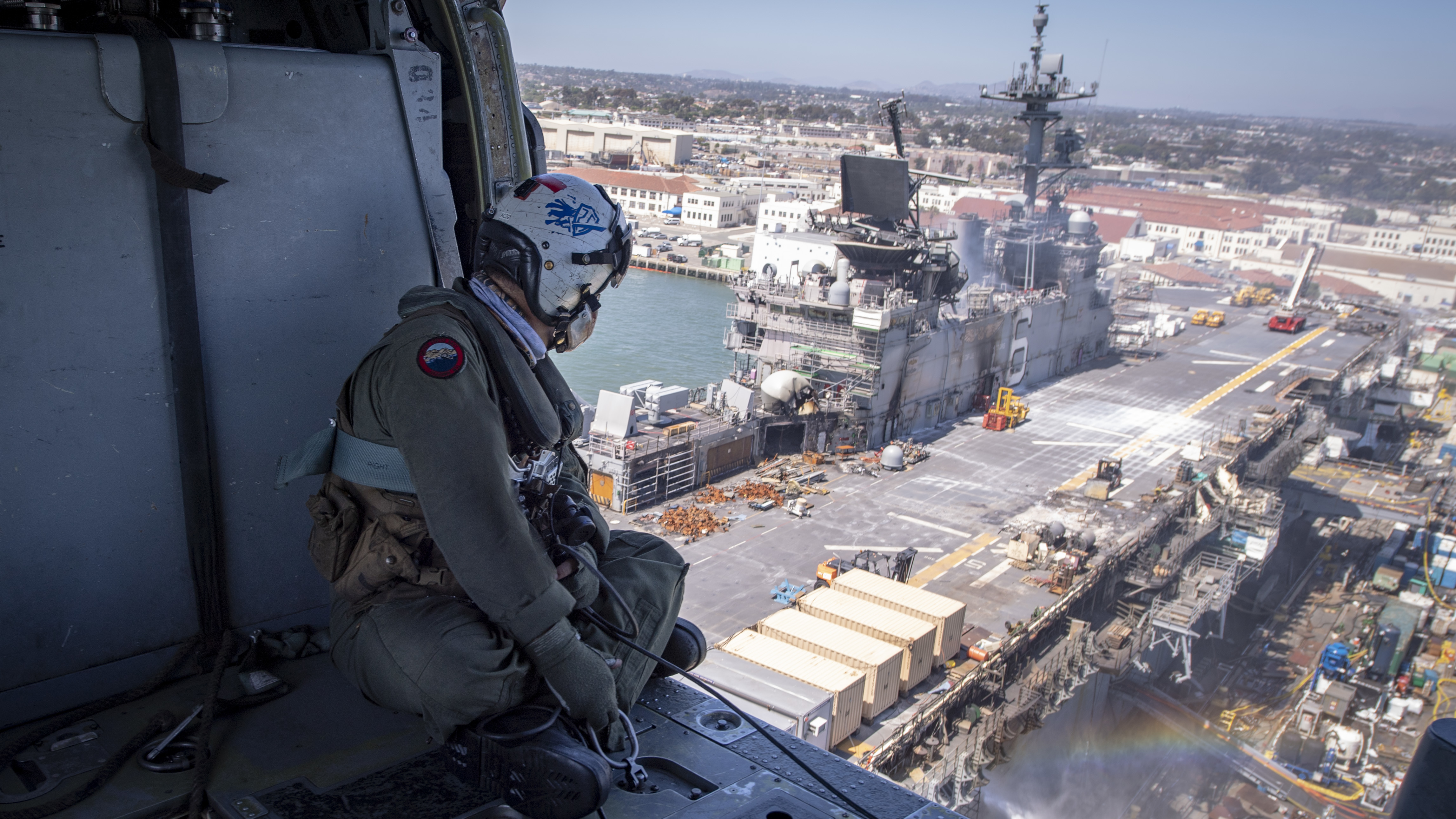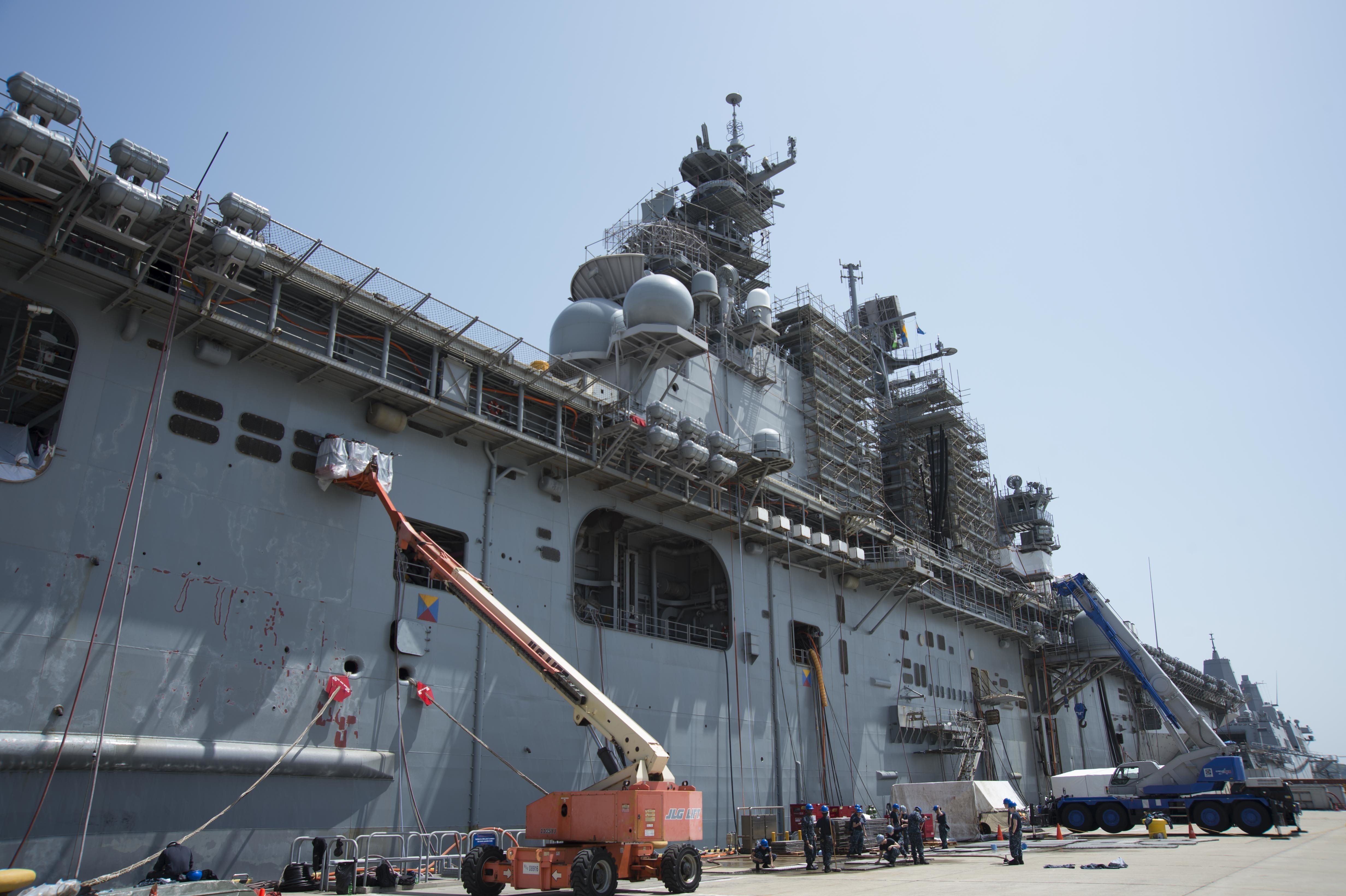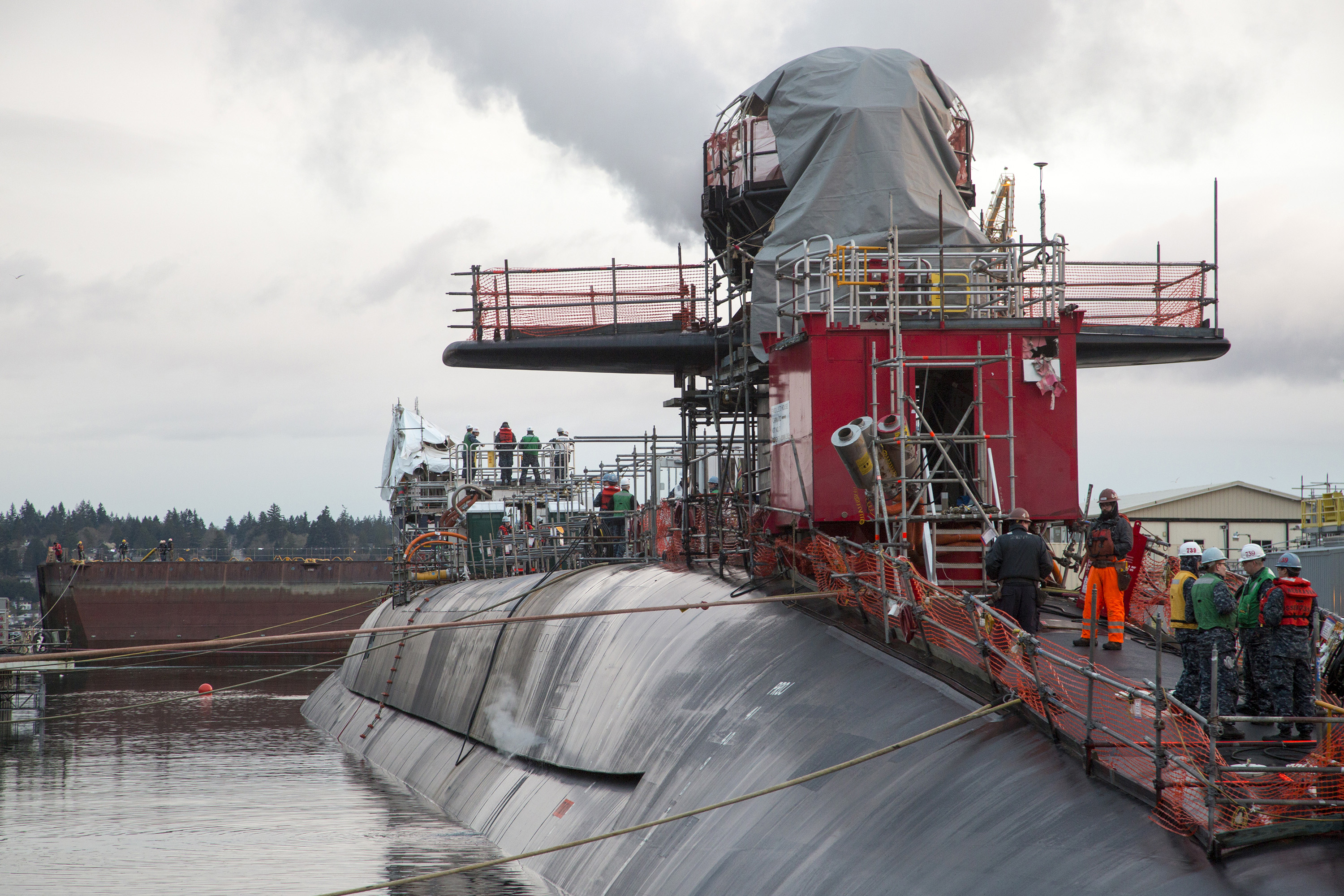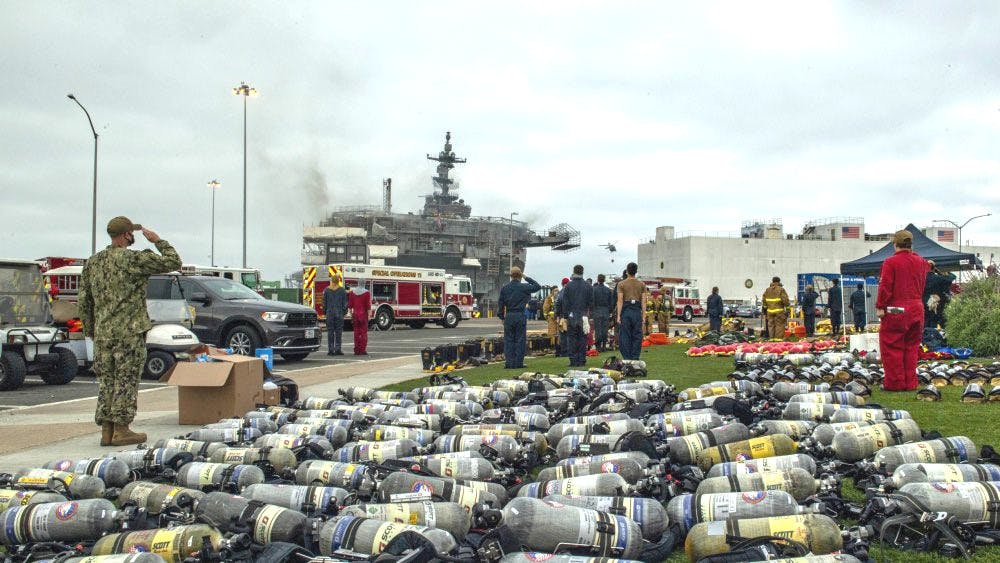The Navy is facing a unique and severe disaster in what could be the total loss of the amphibious assault ship USS Bonhomme Richard. What is so puzzling to many is how this could happen to a capital ship that was unarmed and sitting at rest at one of the world’s most capable naval bases that is situated along the shores of a major American city. The answer may come as disturbing to some—U.S. naval ships can be at their most vulnerable while sitting at rest in their homeport.
Many have also asked what would the situation be like if this had occurred aboard a nuclear-powered supercarrier, three of which are based just across San Diego Bay from the Bonhomme Richard at Naval Base Coronado. The answer to that question is interesting in of itself, but it may actually provide a way to help make sure that similar disasters don’t occur on conventionally-powered vessels in the future.

The Dangers Of Sitting Still
The USS Bonhomme Richard was in an unusual condition on July 12th before an explosion onboard would set the ship ablaze. The amphibious assault ship was wrapping up a significant maintenance period at the General Dynamics NASSCO shipyard and had been moved to Naval Base San Diego’s Pier 2. The maintenance activity was still ongoing at the time of the “casualty,” or accident.
This means many systems were offline. The ship was full of shipyard personnel wrapping up their parts of the project. Under these circumstances, the decks can be littered with welding crews bonding fixtures to the outboards, cutting torches removing old mounts, grinding disks showering sparks into a fire-retardant cloth, and various workspace debris. Other workers would be working on ship’s wiring, air conditioning, and pretty much anything else.

During these maintenance periods, passageways of the ship are often clogged with cables powering temporary light bulbs that cast shadows in corners. White strings tie up thick, black ventilation hoses that hum with air. Temporary alarm panels and fire hoses are mounted at critical locations shrinking the already highly limited corridor space. To provide these services to lower decks, some hatches are “fouled,” preventing or obstructing access. All this dramatically restricts how the crew can move between levels. They have to snake their way past obstructed hatches to get to an available ladder to move to the next level. Sailors and shipyard workers constantly weave around these obstacles during the workday to get to their workspaces.
When a vessel is in a long maintenance availability window, the ship is in a constant state of filth. Dust, fiber, shavings, and oils begin to pool in corners and crevices the moment a vessel begins a refit. If left unattended, this debris quickly becomes kindling for fires.

This noisy, cluttered, hot work environment is precisely the type of fire hazard that sparks disasters onboard ships. Every shipyard worker and crewmember must police themselves and the area around them to identify and mitigate potential flashpoints.
A clean ship is fire-resistant.
Human Factors
During these long in-port periods, many experienced sailors are rotating off the ship to new commands. Many of the crewmen who report to the ship while in a maintenance availability either have not been to sea for years or are new and have never been to sea at all. They may struggle to navigate to their workspace and have never visited some parts of the ship when it is in this condition. This lack of familiarity with their vessel creates delays in response to casualties.
Every month the ship is in maintenance, it becomes more susceptible to disaster, not only from its inherent condition, but from the lack of onboard crew experience.

Many of the crew who do not rotate to new commands are often temporarily detached to other sea commands for experience and proficiency retention. This shrinks the crew below normal manning numbers and removes some of the most experienced sailors from its roster. This leaves the remaining sailors responsible for a large ship they may not be familiar with that is also in a state labyrinthian disarray. Crew manning is a managed risk the command leadership is responsible for maintaining. They must have a proficiently trained crew on the ship during a difficult and long in-port period while providing some of their sailors at sea experience whenever possible.
The maintenance availability environment is ripe for discipline issues. Crews see their ship in pieces with entire systems removed. They know they will not stand a watch at sea for months and it’s easy to fall into a sense of complacency. It is human nature to prepare for the moment and not the eventuality.
At a time when the ship is scheduled to be in port for months, the crew will need management and motivation to train harder because of the lack of sea experience, not despite it. From the deck plate crewman looking up at this top-down management, it appears unnecessarily harsh, and this lowers morale.
It is part of the maintenance availability process. Morale will suffer when sailors are pushed hard in port.

Declining morale ripples across the crew like a tide. It begins with the crew not focusing during training or work parties and showing up late or not showing up at all. The sailor’s uniforms are often stained or dirty from the shipyard environment and cleaning they do every day. If allowed to continue, the crew will spiral into a lethargic, undisciplined pool of individuals who resent their command. This weighs on the crew mentally and instead of serving their country, they feel like they are serving the sweeping broom. Their performance will decline the more prolonged the ship and its crew remain in this condition.
At sea, the USS Bonhomme Richard fire would have been resolved much differently. It probably would not have happened in the first place.

Underway, there is a full complement of crew, many of whom are experienced sailors. They can recognize a casualty and respond before it spreads beyond control. The entire crew is trained to respond cooperatively to an emergency and that training to do so is current and well administered. At sea, the ship is not fouled with temporary fixtures that block the passageways and they are well lit and orderly. At sea, the ship is easier to maintain and clean, preventing the potential spontaneous combustion of discarded materials.
The fire aboard Bonhomme Richard appears to have been started with maintenance debris left unattended in a vehicle storage area. These spaces are in use and monitored more closely while underway.
In other words, if the fire had happened while the ship was underway, it would have been much better prepared to handle the casualty because the crew is trained to prevent, contain, and resolve battle damage. The damage control tools and teams would have been on board, well trained and motivated, and in sufficient numbers to respond quickly.

To minimize the chance of this disaster from repeating itself, the U.S. Navy should look at its practices. In fact, the Navy has the very model for success deployed on their nuclear-powered ships and submarines under the authority of NAVSEA and the U.S. Department of Energy. That model emanates from the Naval Nuclear Propulsion Program, better known as Naval Reactors. Naval Reactors has an excellent track record of few casualties onboard U.S. nuclear-powered ships since its inception. If the Navy would enforce standards required in the maintenance, watchstanding, and operation of nuclear power on all ships, crew performance would improve and we would lose less fighting capability due to poor practices.
Borrowing A Proven Strategy And Applying It To All
Imagine if the Bonhomme Richard was a nuclear-powered ship. That may seem terrifying at first, but the reality is really the opposite. Naval Reactors sets the standard for nuclear-powered ships and submarines in the Navy. These standards are strictly enforced and have a high-level redundancy from top to bottom. From the most complicated evolution involving year-long maintenance availability to relatively simple valve maintenance, every evolution is a minimum two-man operation or reader-worker routine. This breeds accountability. Accountability to each other and for the ship’s combat readiness. Accountability imparts hard work values on sailors. Those values become pride when the task is complete. Pride in a job done well raises morale.
Every sailor must be reminded of their purpose and their value to the crew, especially during long maintenance availability periods.
On a nuclear-powered vessel during a refit period, everything you bring on the ship comes off with you when you leave. A nuclear-powered vessel is not a storage locker for your tools, trash, and rags. This means cardboard and crates are often left on the pier during a refit. Rags and tools are kept with the worker at all times, not stored on board for convenience.
Convenience breeds complacency.
The Navy Reactors’ standard of performance is about much more than reactor safety. It is a standard that creates a culture on board a vessel that is less likely to incur a casualty.

Cleanliness on a ship is a safety issue. This cannot be stressed enough. Dust accumulated is tinder. Oiled rags in an unventilated pile can react chemically and can eventually begin to burn. Workspaces must be inspected after work is complete by a supervisory element. This often falls on the Chief Petty Officer responsible for the area.
It’s about enforcing a command policy that requires shipyard personnel to check out with the duty section when their work is complete. It’s about taking the time to ensure a clean, safe ship environment. This has been the Nuclear Navy’s standard for decades.

The Nuclear Navy is held to an exceedingly high standard, from construction to maintenance to operation, both at sea and during shipyard periods. These practices are reviewed annually by an Operational Reactor Safety Examination inspection team that includes performance standards by the entire crew. The ship itself must meet the Naval Reactors ORSE standard to operate. This demands a culture of high performance and cleanliness that results in fewer fires, or other catastrophes, and a timely response when something goes wrong.
Perhaps, after the Bonhomme Richard disaster, it is time to hold the entire Navy to Naval Reactors’ standards for crew performance, cleanliness, and preservation of our fighting capability. In the event of catastrophic fire or flooding, the nuclear power plant cannot be abandoned. We must not fail.
Let’s bring this attitude to the entire service.

Aaron Amick is a retired U.S. Navy submarine sonarman. He served in both Atlantic and Pacific Oceans on 688 Los Angles class fast attack and Ohio class ballistic missile submarines. He has published two audiobooks on Cold War-era submarines, Akula SSN Project 971 Sub Brief and USS Nautilus SSN-571 Sub Brief. Now, Aaron manages a small Patreon page and contributes to The War Zone.
Contact the editor: Tyler@thedrive.com
